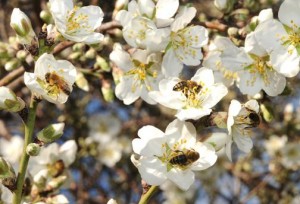As part of an ongoing commitment to honey bee health, the Almond Board of California released a comprehensive, set of Honey Bee Best Management Practices (BMPs) for California’s almond industry. Developed with a wide array of input from sources including the almond community, beekeepers, researchers, California and U.S. regulators, and chemical registrants, the BMPs represent the Board’s most extensive educational documents to date to ensure that almond orchards are and remain a safe and healthy place for honey bees. The documents lay out simple, practical steps that almond growers can take together with beekeepers and other pollination stakeholders to protect and promote bee health on their land and in the surrounding community.
(The) release builds on decades of work by the almond industry. Since 1995, the Almond Board of California has invested almost $1.6 million – more than any other crop – on research related to honey bee health, on subjects including Varroa mite and other honey bee pest and disease management, nutrition and honey bee forage, impact of pesticides, and technical assistance for beekeepers. Almond orchards are often honey bees first source of natural pollen after the winter, and honey bee hives routinely leave the almond orchard stronger than they arrived.1
“Nobody is a bigger fan of honey bees than almond growers. Without bees, there would be no almonds. And without almonds, bees would lose a vital source of nutritious natural pollen,” said Richard Waycott, CEO of the Almond Board of California. “These Best Management Practices are another significant milestone in our decades-long commitment to protect bee health and preserve that mutually beneficial relationship.”
“With these Best Management Practices, the Almond Board is responding strongly on honey bee health and, in particular, pesticide use and considerations during bloom,” said Dr. Eric Mussen, UC Davis Extension Apiculturist Emeritus. “Their recommendations actually go far beyond the almond orchard, providing important insights for all crops when it comes to promoting honey bee health.”
The BMPs emphasize the importance of communication among everyone involved in pollination, including beekeepers, bee brokers, farm owners/lessees, farm managers, pest control advisers and applicators. The wide ranging recommendations include information on:
- Preparing for honey bee arrival;
- Assessing hive strength and quality;
- Providing clean water for bees to drink;
- Using Integrated Pest Management (IPM) strategies to minimize agricultural sprays;
- Removing honey bees from the orchard; and
- Addressing suspected pesticide-related honey bee losses
While experts have attributed honey bee health decline to a variety of factors including pests, decreasing sources of natural pollen, and lack of genetic diversity, the BMPs focus significantly on pesticide application practices and considerations during almond bloom – with lessons that apply to the multitude of other crops that rely on honey bees and that use pesticides and fungicides.2 Among the specific recommendations:
- There should be agreement between beekeeper and grower on a pesticide plan that outlines which pest control materials may be used.
- Insecticide applications should be avoided at bloom until more is known about their impact on young developing bees in the hive (bee brood).
- Tank mixing insecticides with fungicides should be avoided.
- If fungicide application is needed during bloom, it should take place in the late afternoon and evening, when bees and pollen are not present. This avoids contaminating pollen with spray materials.
Along with the full Best Management Practices, (the) release includes a Honey Bee Best Management Practices Quick Guide for Almonds, and Applicator/Driver Honey Bee Best Management Practices Quick Guide for Almonds. The guide for applicators and drivers is available in both English and Spanish to ensure maximum accessibility and adoption. Each of the documents is available in full atwww.Almonds.com/BeeBMPs.




3 Responses to Almond Board of California introduces best practices for bees